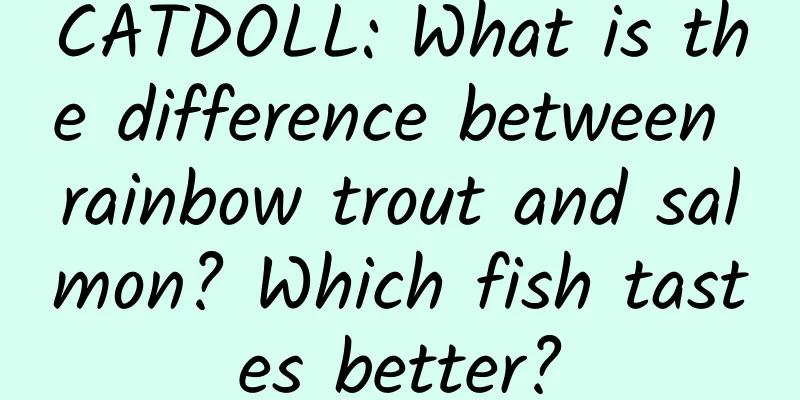CATDOLL : CATDOLL: How to distinguish salmon from rainbow trout

|
Rainbow trout is a freshwater fish, but it is not freshwater salmon. It is not suitable to be eaten raw because it is easy to be infected with parasites. Salmon is a marine fish. Generally, marine salmon that has been frozen at low temperatures is relatively safe to eat raw. There is a long red line on the body of rainbow trout, the meat is lighter in color, and the fat line stripes are narrow and not obvious. The color of salmon meat is bright, and the fat line stripes are wide and obvious. Rainbow Trout Illustration At present, the group standard for "Raw Salmon" clearly states that rainbow trout and other fish are classified as salmon. This standard has caused a lot of controversy and has been questioned by consumers, who say that the "domestic salmon" farmed in my country is actually rainbow trout, not the salmon we usually call. Rainbow trout is not authentic salmon and is likely to have parasites. However, there are two opinions about this standard. Salmon illustration 1. The first statement is that the salmon mentioned in the Chinese market is a general term for salmon and trout, not the scientific name of a fish, so rainbow trout is salmon. For example, tuna includes bluefin tuna, yellowfin tuna, bigeye tuna, bonito, etc., so salmon also includes Pacific salmon, Atlantic salmon, rainbow trout, etc. 2. The second type is what people usually call salmon, which is Atlantic salmon, a kind of marine fish. Although salmon and rainbow trout belong to the same family, the English names of salmon and rainbow trout are different. The English name of salmon is "Salom", while the English name of rainbow trout is "rainbow trout", so the common English name of salmon excludes rainbow trout. Rainbow Trout Illustration How to quickly identify salmon and rainbow trout 1. Look at the fish skin. Look at the skin of the whole fish to see if there is a red line running from the upper part of the body to the tail. If there is a red line, it is rainbow trout, if not, it is salmon. 2. The difference in fish meat. The color of rainbow trout meat is light orange, and its fat line stripes are relatively narrow and not very obvious. The color of salmon meat is brighter orange-red, and its stripes are wider and very obvious. Salmon illustration The specific difference between rainbow trout and salmon 1. Size: Salmon is larger than rainbow trout. Salmon is usually over 1 meter long, while rainbow trout is much smaller than salmon. 2. Fish price. The market price of rainbow trout is about 30 yuan per catty, but the market price of Norwegian salmon is very high. If you buy sashimi at a lower price, it is likely to be rainbow trout or stale salmon. 3. Difference in meat quality. Because Norwegian salmon is a marine fish that lives in the Atlantic Ocean, its fat content is relatively high, so the white fat lines are relatively wide and obvious. Rainbow trout is a freshwater fish, so its fat content is low, and the fat lines are relatively thin and blurred. Another difference is the thickness of the fish slices. Norwegian salmon is relatively soft and tender, and is usually cut into a thickness of about 0.7~1cm, which is already relatively thick. However, the meat of rainbow trout is relatively hard, and it will be more difficult to bite if it is cut so thick. Salmon meat is bright in color, while rainbow trout meat is dull and has no luster. 4. Fish taste. High-quality salmon has a delicate and tender texture, so it can be cut very thickly. The meat is firm and full, rich in fish oil, full of elasticity, and has a very chewy and smooth taste. The salmon also has a special aroma. Rainbow trout has a harder meat and does not have this feature. 5. Types. Salmon is a marine fish that grows in the ocean, while rainbow trout is a freshwater fish in China. Therefore, the species are completely different. 1863 reads Search Rainbow trout Golden trout photos 30 seconds to distinguish between real and fake salmon Salmon and rainbow trout difference pictures Rainbow trout Salmon photos Seven tips for fishing rainbow trout The difference between salmon and trout 1. Dental characteristics Salmon has no teeth on the upper and lower sides of its mouth, and only a few teeth in the middle of its mouth; rainbow trout has serrated fangs on both sides of its mouth. Salmon is slender like a submarine, while rainbow trout is wider and has a larger abdomen. Salmon scales are extremely small and difficult to see with the naked eye; rainbow trout scales are larger. 2. Fish size Salmon can grow to more than one meter in length and weigh about 5-20 kilograms each, while rainbow trout is much smaller, generally weighing about 1.5 kilograms. Adult rainbow trout have a broad and bright purple-red and pink rainbow band along their lateral line, while salmon do not. Rainbow trout cannot be eaten raw, and freshwater fish cannot be eaten raw. Freshwater fish and shrimps usually cannot be eaten raw, as they carry a variety of parasites in their bodies. Eating freshwater fish raw is more or less a risk of infection with parasites. 3. Living space The "salmon" farmed on the Qinghai-Tibet Plateau is rainbow trout. Rainbow trout lives in low-temperature fresh water all its life. The salmon we call are all marine fish. Therefore, rainbow trout farmed in freshwater cannot be called "freshwater salmon". What we often say is Atlantic salmon for raw food. The salmon we often talk about is Atlantic salmon, also called Norwegian salmon. Pacific salmon is also salmon. Both Atlantic salmon and Pacific salmon are marine fish. 4. Meaty texture Salmon can effectively lower cholesterol and blood lipids, and as a marine fish, its meat is very elastic, tender and delicious, and has a fishy flavor, which is loved by many people who like to eat raw fish. However, as a freshwater fish, rainbow trout is not as delicious, its meat is harder and not as crispy, and because it is a freshwater fish, it is easy to have parasites if it is wild, so rainbow trout cannot be eaten raw. 5. Appearance and color Generally, observing the lines is the best way to visually distinguish the two fish. Salmon is fatter and has a yellowish flesh, while rainbow trout is reddish. In addition, salmon has a more delicate texture and looks smoother, while rainbow trout has coarser fibers. If cut into slices of the same thickness, rainbow trout will be harder to chew. Salmon has attracted a large number of fans due to its attractive color, smooth texture, delicious taste and high nutritional value. When it comes to salmon, many people will naturally think of the vast blue ocean and think that salmon is a kind of deep-sea fish. But in recent days, reports about salmon have caused a stir. Some reports point out that my country's Qinghai-Tibet Plateau began to farm salmon a long time ago and currently occupies one-third of the domestic salmon market. A Weibo user named "Biologist Who Opens an Aquarium" who is certified as a fishery expert reposted the report and said that the so-called domestic salmon is not the same fish as the salmon known to consumers. It is actually freshwater rainbow trout, which has parasites that can directly parasitize the human body and there is a high risk of eating it raw. There are different opinions on the salmon debate. So, is rainbow trout salmon? Is there a risk of parasites in salmon? Can rainbow trout be eaten raw? Here are some answers to your questions. Is rainbow trout salmon? The "domestic salmon" farmed in my country is actually rainbow trout. The two sides have different opinions on whether rainbow trout is a type of salmon. Supporters said: In the Chinese market, salmon is a general trade name for salmon and trout, not a scientific name for a fish. Just like the tuna that Chinese people eat on their tables, including yellowfin tuna, bluefin tuna, bigeye tuna, bonito, etc. Salmon also includes Atlantic salmon, Pacific salmon, rainbow trout and other species. The opponents said: What we usually call salmon is actually "Salmon", which belongs to Atlantic salmon, a kind of marine fish. Although rainbow trout belongs to the Pacific salmon genus, the common English name of rainbow trout is rainbow trout, so rainbow trout is excluded from the concept of "Salmon" common name. Some species of Pacific salmon (breeding season) Image: arkive.org And the corresponding concept of "Trout" is "trout", which refers to a group of fish in the genera Salmon (Pacific salmon) and Salmon that complete their entire life history in freshwater and do not have cross-salinity migration behavior. Rainbow trout is an example of this (special examples include landlocked Atlantic salmon and migratory steelhead trout, which are varieties based on individual populations with extremely small natural distributions, and are not enough to affect commercial varieties formed by artificial selection). Is there a parasite risk with salmon? In fact, salmon may also have the risk of parasites. Salmon may be infected with Anisakis and Diphyllobothrium. Then why can it be eaten raw as sashimi? This is because the salmon we eat are all frozen. The parasites that salmon are susceptible to have complex biological structures and are very afraid of cold. Once they are frozen at low temperatures, they will be killed. Marine fish from regular channels are usually frozen quickly at low temperatures in accordance with regulations, at minus 35 degrees Celsius for 15 hours or minus 23 degrees Celsius for a week, so it is relatively safe to eat raw. Is rainbow trout edible? What about eating it raw? Rainbow trout is not only edible, but also delicious. It has the unique flavor of salmon, a high fat content, a delicate texture and chewy meat, and is especially suitable for frying and grilling. Of course, it is also good for steaming, braising and hot pot. Can rainbow trout be eaten raw? There are also differences of opinion on whether rainbow trout, as a freshwater fish, can be safely eaten as sashimi. Supporters say: Wild fish are prone to parasites, while those farmed in a formal way do not. Similarly, whether salmon have parasites or not is not determined by whether they are grown in seawater or freshwater, but by whether their growth process is safe and controllable. Industrially farmed salmon with standardized management, strict monitoring, clean water, and good feed are easier to guarantee quality and safer to eat. Opponents said: Rainbow trout is a freshwater fish, and freshwater fish and shrimp are usually not eaten raw. Because they may carry a variety of parasites in their bodies, such as Diphyllobothrium latum, Lung fluke, Clonorchis sinensis (commonly known as liver fluke), Gnatostoma nematodes, etc. Moreover, freshwater fish parasites can directly parasitize the human body, and the risk of infection is very high if eaten raw. Once infected, it is very dangerous. Moreover, even if you dip soy sauce, vinegar, mustard sauce, or drink white wine when eating, it is not enough to kill these parasites. How to tell the difference between salmon and rainbow trout? price Salmon: Basically, the market price of the most expensive Norwegian salmon is about 80-100 yuan per catty. Rainbow trout: The price of domestically farmed rainbow trout is about 30 yuan per catty. The price can still reflect the authenticity of the ingredients to a certain extent. Flesh color Salmon: Norwegian salmon has a relatively higher fat content, orange-yellow flesh, whiter white patterns on the surface, wider lines, and fuzzy edges. Canadian salmon has a relatively lower fat content, reddish flesh, and less obvious white patterns on the surface. Rainbow trout: low in fat, thin lines and hard edges, that is, the red and white stripes are very obvious. thickness Salmon: Fish fillets are usually cut into thick pieces (about 0.7cm-1cm), and the thickness is very thick. Rainbow trout: Because the meat is relatively hard, it cannot be cut so thick, otherwise it will be difficult to bite. luster Salmon: It looks shiny and oily, and it reflects light faintly under the light. Rainbow Trout: Dull in the light. Taste Salmon: Higher quality salmon can be cut very thickly, so it is firm and full in the mouth, with rich fish oil and a melt-in-the-mouth feeling. It is very elastic and you will feel the meat constantly squeezing your teeth and mouth when chewing. Rainbow trout: I don’t have that feeling. In short, the "salmon sashimi" with cheap price, reddish meat color, thin sashimi thickness, narrow and clear fat texture, and dull meat surface is more likely to be rainbow trout. The difference between salmon and rainbow trout: First of all, the price. Basically, the market price of the most expensive Norwegian salmon is 80-100 yuan/jin, while the price of domestically farmed rainbow trout is 30 yuan/jin. So if you buy sashimi, the price is below 50, either it is rainbow trout, or it is old and not fresh. In various Japanese restaurants or seafood buffets, I have encountered 110 yuan per person and some use Norwegian salmon, and 250 yuan per person and Canadian salmon, so it is still necessary to distinguish in advance based on the comments of netizens on Dianping. Second, judge from the appearance. This is actually quite obvious. Norwegian salmon has a relatively higher fat content, the flesh color is orange-yellow, and the white pattern on the surface is whiter; while Canadian salmon has a relatively low fat content, so the flesh color is reddish and the white pattern on the surface is not obvious. Therefore, salmon with orange flesh color is Norwegian salmon. As for rainbow trout, I can only say that the Chinese people's counterfeiting level is invincible. Now rainbow trout can be very similar to salmon. Here I give you a few angles for you to observe. The first is the fat lines (that is, white lines). The lines of Norwegian salmon are wider because it lives in the Atlantic Ocean and has a higher fat content. Specifically, the white lines are wider and the edges of the lines are more blurred. The fat content of rainbow trout is low, so the lines are thin and the edges are very hard, that is, the red and white are very obvious. The second is the thickness of the fish fillet. Norwegian salmon is generally cut into thick pieces (about 0.7cm-1cm), and the thickness is very thick. However, due to the hard meat of rainbow trout, it cannot be cut so thick, otherwise it will be difficult to bite. The third is the gloss on the surface of the meat. Norwegian salmon looks shiny and glossy, and faintly reflects light under the light, while rainbow trout is dull. Third, judge by taste. At this point, it can only be said that you will decide whether you will consume this salmon next time. The better quality salmon can be cut very thick, so it is firm and full in the mouth, rich in fish oil and melts in the mouth. Because it is very elastic, you will feel that the meat is constantly squeezing your teeth and mouth when chewing; rainbow trout does not have this feeling. In short, salmon sashimi that is cheap, has a reddish color, is thin, has a narrow and clear fat texture, and has a dull meat surface is more likely to be rainbow trout. Rainbow trout and salmon are very similar. Anglers who don't know much about them think they are the same kind of fish. Diners who like to eat sashimi may easily mistake rainbow trout sashimi for salmon sashimi if they don't know this. However, the prices of these two fish in the market are very different. Now I will popularize the relevant knowledge about rainbow trout and salmon, as well as how to distinguish the differences between the two. Salmon, rainbow trout and king salmon are all collectively referred to as salmonids. The difference is that one belongs to the genus Salmon of the family Salmonidae, and the other belongs to the genus Trout of the family Salmonidae. The salmon mentioned in the market refers specifically to Norwegian salmon, mainly Atlantic salmon. Finnish salmon is what we call rainbow trout, and American salmon refers to Alaskan salmon, which is called Pacific salmon like the king salmon produced in our Northeast region and Russia. Remember, the real salmon refers specifically to Norwegian salmon produced in Norway. Why is it necessary to make such a distinction? Because many tourist attractions deceive tourists and sell rainbow trout as Norwegian salmon! The price of salmon is high, and the general market price is about 80 to 100 yuan per catty, while the price of rainbow trout is between 30 and 50 yuan per catty. All salmon have spots on their bodies. How to distinguish rainbow trout from salmon? It is relatively easy to distinguish salmon and rainbow trout from the appearance. Salmon has conspicuous white lines due to its high fat content, while rainbow trout has rainbow-like spots. However, it is a little more difficult to distinguish from the fish meat, but it is not difficult to identify the difference between them as long as you carefully identify them. Both salmon and rainbow trout are suitable for sashimi. You can tell them apart by the color of the meat and the texture of the fat. Salmon: Norwegian salmon has a bright color, orange-red meat, clear fat lines, firm meat, no blood or bruises. It feels elastic, the meat is tight and not sticky.  Norwegian salmon  The fat texture of Norwegian salmon is clear and orange-yellow Rainbow trout: The meat of rainbow trout is dark red, with incomplete fat lines and is relatively hard. The meat feels loose and not easy to bounce.  Rainbow trout flesh, dark in color The difference in the fish meat is even greater after cooking. The cooked salmon meat is pink in color, tender and delicious, sweet and tasty; the cooked rainbow trout is sometimes white in color, sometimes darker in color, and tastes woody and dry. Introduction to three types of salmonids 1. Rainbow Trout Rainbow trout is a cold-water pond fish of the genus Pacific salmon in the family Salmonidae. It is native to the Pacific coast of North America and is mainly distributed in the waters west of the Rocky Mountains, from Alaska to northwestern Mexico. It was later introduced to countries around the world. Rainbow trout is an important cold-water fish that is widely farmed in the world. The lateral line of mature individuals has brown-red longitudinal stripes, and a wide and bright red rainbow band of purple-red and pink, which extends to the base of the tail fin like a rainbow, hence the name. It mainly lives in low-temperature freshwater and has high requirements for the water quality of the breeding waters. The rainbow trout in China is an introduced variety. Most of them are distributed in Beijing, Heilongjiang, Shandong, Shanxi, Liaoning, Jilin, Shaanxi, Sichuan and other provinces and cities. For example, the density of rainbow trout in Liujiaxia Reservoir in Gansu is relatively high, and it is deeply loved by anglers. Some places in the south that are not suitable for rainbow trout farming are also suitable for rainbow trout survival, such as Dongjiang Lake in Chenzhou, Hunan.  Rainbow Trout 2. Norwegian salmon Salmon, also known as salmon or salmon, is one of the most commonly used fish ingredients in Western cuisine. In the consumer markets of different countries, salmon covers different types. Norwegian salmon is mainly Atlantic salmon. Salmon is not equal to salmon, just like the relationship between salt and sodium chloride. Salmon generally refers to Atlantic salmon. Salmons are fusiform in shape and have well-developed teeth. All fins except the adipose fin have black edges. The color of Atlantic salmon juveniles is different from that of adults. When they are still living in fresh water, they have blue and red spots on their bodies. When they enter the sea, they become silvery blue. The most recognizable thing about them is the black spots on their lateral lines. When they are breeding, males become light green or red.  Norwegian salmon 3. Salmon Salmon is also known as salmon, big salmon, and dafaha. The body gradually bulges from the back of the head to the base of the dorsal fin. The starting point of the dorsal fin is the highest point of the body, and it gradually bends downward toward the tail. The head is flat on the side. The snout is protruding, slightly curved, and shaped like a bird's beak. In the reproductive season, the protrusion of the male fish is most obvious, and it bends towards each other like a clamp, so that the upper and lower jaws do not match. The upper and lower jaw vomerine teeth are very developed. The tail fin is shallowly forked. When entering the tributaries of rivers in March, the body color is silvery white or scattered with small black spots, with dark horizontal stripes on both sides, and the color becomes brighter in the reproductive season. When living in the ocean, the body is silvery white. It is a genus of fish in the Pacific salmon genus of the Salmonidae family. It is a cold-water upstream spawning migratory fish distributed in the northern Pacific Ocean and the Arctic Ocean. The body color of salmon in the marine environment is silvery white.  Salmon Salmon entering the breeding season are brightly colored. |
<<: CATDOLL: Can white shrimp and crucian carp be raised together?
>>: CATDOLL: How do snails reproduce?
Recommend
Peterbald cat temperament introduction
Peterbald Cat Temperament: Peterbald cats love to...
CATDOLL: Can someone teach me how to fish for mullet? Thanks in advance.
1. Who can teach me how to fish mullet? Thank you...
CATDOLL: How to raise saltwater fish?
1. How to raise saltwater fish? How to raise salt...
CATDOLL: The fastest recipe for chickens to lay eggs
The fastest recipe for chickens to lay eggs The n...
CATDOLL: How many species of shellfish are there in the world?
●There are 120,000 species of shellfish in the wo...
CATDOLL: Silverfish are extremely valuable and expensive. What should we pay attention to when breeding silverfish?
Silverfish are of extremely high value and very e...
CATDOLL: What are the costs and profits of farming snails?
1. What is the profit of raising a thousand snail...
CATDOLL: How to operate a breeding pig base to obtain rich profits
Breeding has always been an important part of the...
CATDOLL: What to do if a large amount of green algae appears in shrimp farming
What to do if a large amount of green algae appea...
CATDOLL: Beekeeping Technical Guidance (IV) (Beekeeping Technical Guidance (III))
1. Explanation of double-box beekeeping technolog...
Are cat ears hot or cold?
Normally, a cat's ears are cooler. The reason...
CATDOLL: How to best breed earthworms
How to breed earthworms best Generally speaking, ...
CATDOLL: What medicine should I use if my fish are infected with Ichthyophthirius?
1. Increase water temperature Ichthyophthirius mu...
CATDOLL: How to treat chicken pox? | Treatment methods and precautions for chicken pox
How to treat chicken pox? Chicken pox is a contag...
CATDOLL: Video tutorials on silkworm rearing technology (full video tutorials on silkworm rearing technology)
1. A beginner’s guide to silkworm farming? 1. Bre...









